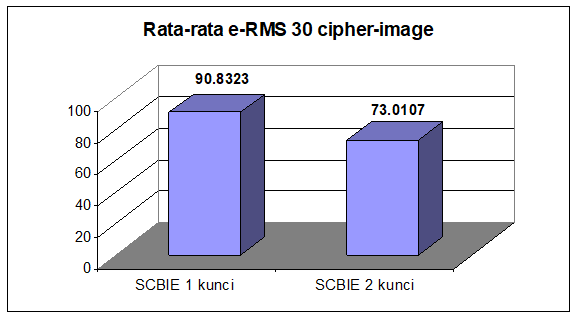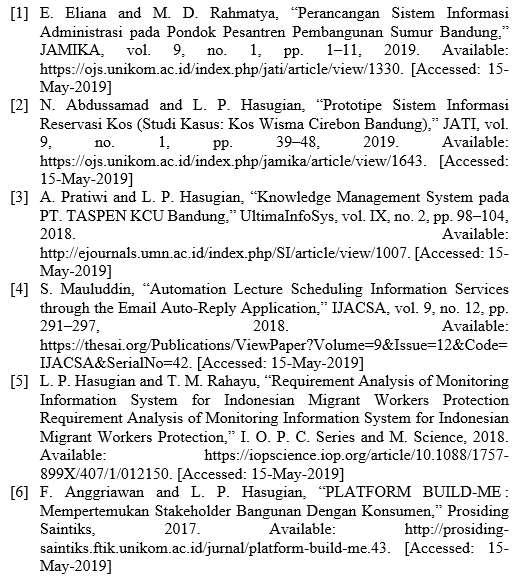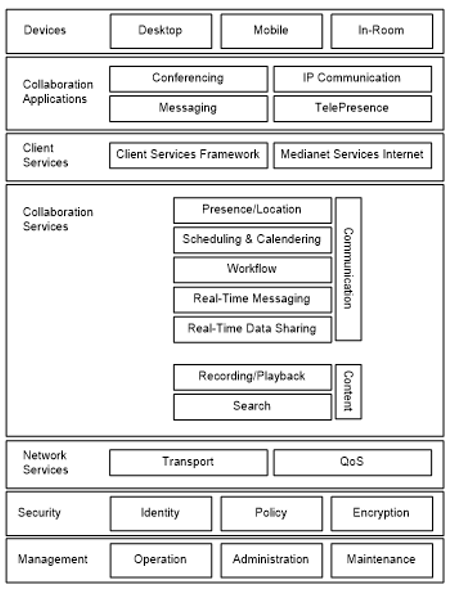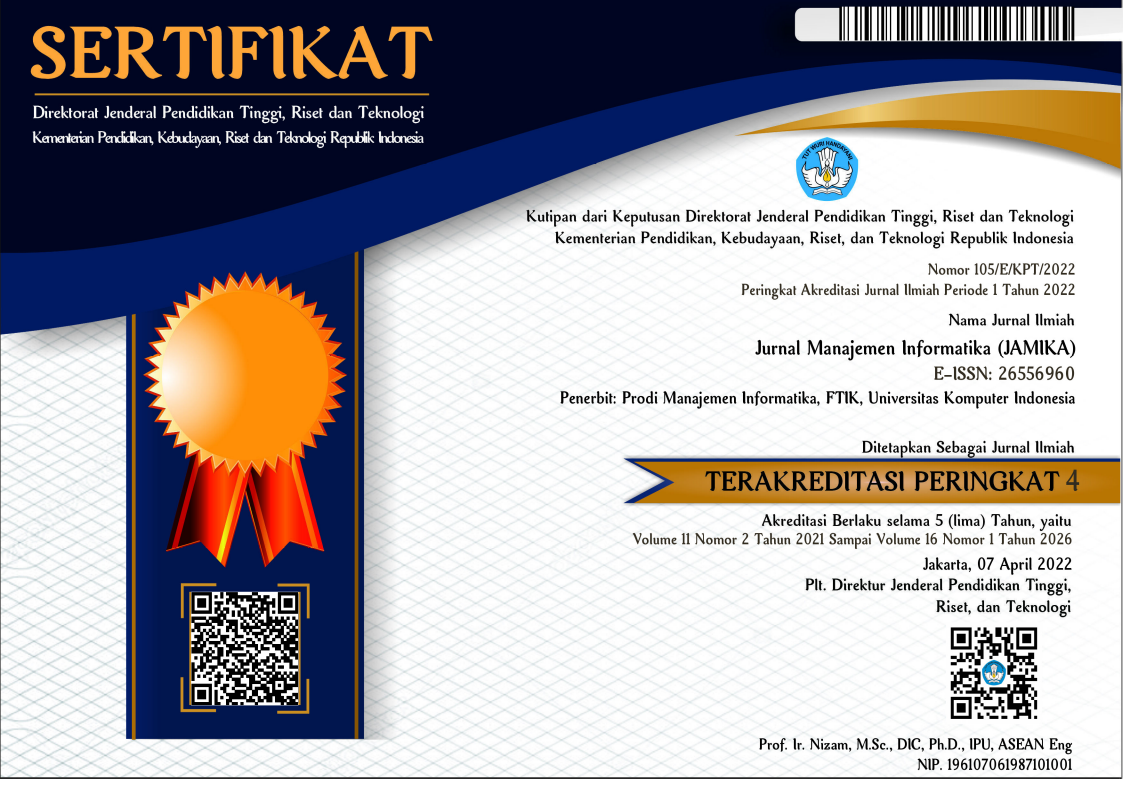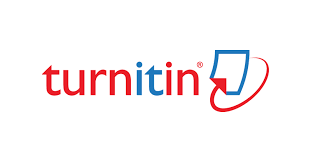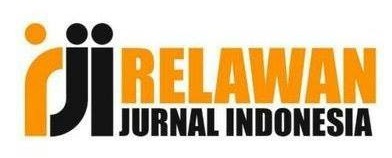Jurnal Manajemen Informatika (JAMIKA)
ISSN (Print): 2088-4125
ISSN (Online): 2655-6960
Author Guidelines
- Original manuscripts and have never been published in other media.
- Manuscripts are written in Indonesian or English, using the font Times New Roman 12, space 1, single column, on A4 paper with a left margin of 3 cm, top margin of 3 cm, bottom and right 2.5 cm and a number of pages 6 to 16 pages , sent via: https://ojs.unikom.ac.id/index.php/jamika/index
- The manuscript is organized into the following structure:
- A concise and clear title with a maximum of 12 words.
- Author name, affiliation, and corresponding author's email.
- Abstract is written in Bahasa and in English in maximum of 200 words in italics with Times New Roman 10 point. Abstract should be clear, descriptive, and should provide the aim of research, the method used to solve the problem, and the result(s). Abstract preferably end with a comment about the importance of the results or conclusions briefly.
- [1. Introduction], The introduction describes the background of the problem being solved, issues related to the problem being solved, the basis for consideration, research objectives, and reviews of research that has been done previously by other researchers that are relevant to the research being conducted. Also explain what makes your research different or superior from previous research so that it looks novelty and where your research position is. It is recommended that there are at least 2-3 previous studies that are reviewed in the introduction section. The manuscript of each section in each paragraph is written in Times New Roman font, size 10 points, with 1 spacing, and 1 cm indentation for each paragraph.
- [3. Research Methods], Research methods include problem analysis, architecture or design methods used to solve problems. The research method is described through a flow chart and is accompanied by an explanation of each stage of the research method related to the research conducted. Problem analysis describes the problems that exist and are resolved in this study. The design describes how to solve the problem and should be presented in the form of a diagram with a complete explanation. For example data processing diagrams, from raw data to finished, hardware design diagrams. Also include the time and place of the research.
- [4. Results and Discussion], This section contains the results of research or experiments and analysis of research results or experimental results. Research results should be represented in a relevant form, for example displayed in the form of pictures, graphs, or tables. For images, it can follow a format like Figure 1. For graphics, it can follow a format like Figure 2. A discussion of the results of research and testing obtained is presented in the form of theoretical descriptions, both qualitatively and quantitatively. Write a comparison between your research and previous research. Also write down the benefits and contributions of the research as well as the drawbacks of the research you did.
Figure 2. Ncncn comparison chart
Table 1. Comparison of Algorithm A and Algorithm B
- [5. Conclusion], The conclusion should clearly indicate the results obtained and the advantages and disadvantages. The conclusion is in the form of a paragraph, it should not be in the form of bullet points or numbering. Conclusions answer the research objectives. Conclusions no longer contain discussions, quotes, pictures or tables. Also provide suggestions for further development.
- Acknowledgement, this section is optional. If any, then thanks are addressed to the parties involved in the research (such as parties to the licensing process, data collection, etc.) or to the institution that has provided financial support for your research.
- [Reference], At least 20 libraries are listed and only contain libraries that are referred to in the written manuscript, not just listed libraries. Libraries are written in the order in which references appear in the text, not in alphabetical order by the author. The reference composition used must consist of a minimum of 80% primary references (journals and proceedings) and a maximum of 20% secondary references (books, verified websites, for example: kompas.com, bps.go.id, etc.). References published in 2020-2024. It is preferable that the entire literature comes from journals. Reference is done by writing the serial number in the bibliography in square brackets, for example [1], [1,2], [1-3]. Bibliography that is referred to in the manuscript must be in the Bibliography and every reference in the bibliography must be referenced in the manuscript. The first cited literature referred to in manuscript [1], must be in bibliography no. 1, which is cited second, appears in bibliography no. 2, and so on. The order in the bibliography must be in the order in which citations appear, not last name. Reference is written using the IEEE system format. Each reference is cited using a number and it is recommended that it be placed at the end of the sentence. It is advisable to use a software application for managing references and bibliographies, (for example: Mendeley).
- Each table or figure is given a serial number, a title that matches the contents of the table or figure, and the source of the citation (if relevant) and must be referred to in the paragraph. All figures and tables that you enter in the document must be adjusted to the order of 1 column or the full size of one paper with dots (.), Without bold (Bold), and must be accompanied by a sentence that refers to the figure / table, in order to make it easier for reviewers to observe. meaning of the picture. Example: ...... shown in Figure 1 or ...... shown in Table 1. If you are using Word use the Layout Options: In Line with Text to position the image following the text.
Figure 1. Cisco Collaboration Architecture
- Mathematical formulas / equations, if you use Word, use the Microsoft Equation Editor or MathType equation, written in the middle, and numbered equations starting from (1), (2), etc. Each equation that appears must be accompanied by a sentence that refers to the equation. Example: ...... shown in equation (1).
You can download Author Guidelines here

